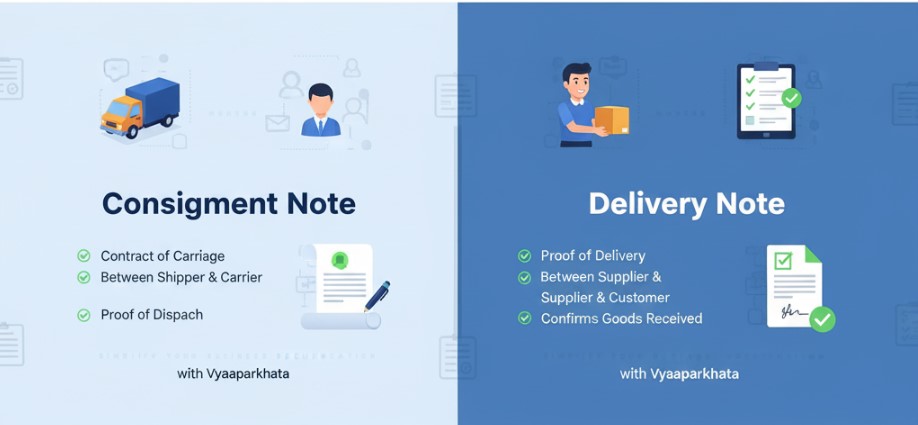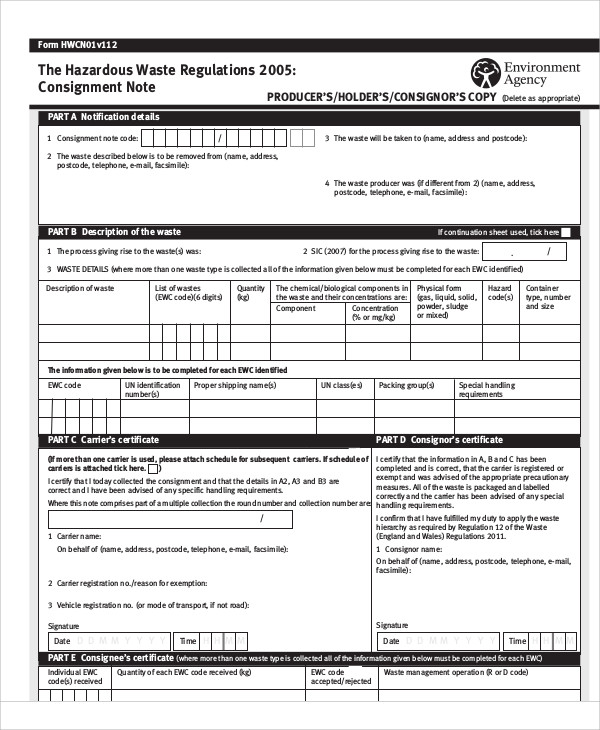
In the world of business, logistics, and trade, documentation plays a crucial role in ensuring smooth operations. Two of the most commonly used documents are the Consignment Note and the Delivery Note. While both are important for recording the movement of goods, they serve different purposes. Many businesses often confuse the two, which may result in compliance issues or operational inefficiencies.
This blog explains the difference between consignment note and delivery note, their importance, and why every business should understand and use them correctly.
What is a Consignment Note?
A consignment note is a transport document issued by the consignor (sender of goods) or by the carrier (such as a logistics or transport company). It acts as a contract of carriage between the consignor and the transporter.
Consignment Note For Hazardous Waste Regulations

Key Purposes:
- Acts as proof that the transporter has received the goods.
- Serves as a contract for transporting goods from one place to another.
- Provides legal validity in case of disputes.
Information Included in a Consignment Note:
- Name and address of consignor and consignee
- Description of goods (type, weight, volume, quantity)
- Transport details (vehicle number, route, date)
- Delivery instructions
- Signature of consignor and carrier
Example: When a manufacturer sends goods via a trucking company, a consignment note is prepared to confirm that the transporter has accepted the goods for delivery.
What is a Delivery Note?
A delivery note is a document that accompanies goods during delivery, issued by the seller or supplier. Unlike a consignment note, it is not a legal contract, but rather a record that the goods delivered match the order placed by the buyer.
Key Purposes:
- Ensures the delivered goods match the purchase order.
- Provides proof of delivery for both seller and buyer.
- Helps with accounting, auditing, and stock reconciliation.
Information Included in a Delivery Note:
- Seller and buyer details
- List of items delivered
- Quantity and description of goods
- Delivery address and date
- Receiver’s acknowledgment signature
Example: When a customer receives ordered items from a supplier, the delivery note confirms that the goods listed were actually delivered.
Consignment Note vs Delivery Note: Key Differences
| Aspect | Consignment Note | Delivery Note |
|---|---|---|
| Issued By | Consignor / Transporter | Seller / Supplier |
| Purpose | Proof of carriage contract | Proof of goods delivered |
| Legal Value | Acts as a contract between consignor & carrier | Supporting document, no contractual effect |
| Contents | Consignor, consignee, transport details, goods description | Seller, buyer, list of goods, quantities, acknowledgment |
| Receiver | Carrier (for transport purpose) | Buyer/consignee (for verification) |
| Usage Example | Manufacturer sending goods through a logistics company | Buyer confirming delivery of ordered goods |
Why the Distinction Matters
Understanding the difference between a consignment note and a delivery note is crucial for:
- Compliance with transport and trade laws.
- Avoiding disputes between consignor, consignee, and transporter.
- Efficient record-keeping for invoices, stock, and taxation.
- Smooth logistics and timely deliveries.
Without proper documentation, businesses risk errors in accounting, missed deliveries, or even legal complications.
Practical Example
Let’s consider a simple business transaction:
- Step 1: A manufacturer sends goods to a customer via a logistics provider. A consignment note is issued as proof that the transporter has received the goods.
- Step 2: When the customer receives the goods, they sign the delivery note to confirm the items match the order.
Here, the consignment note ensures legal transport, while the delivery note ensures customer satisfaction and order accuracy.
Common Mistakes Businesses Make
- Using delivery notes instead of consignment notes for transport documentation.
- Not including all required details (signatures, descriptions, or dates).
- Failing to keep copies of documents for audit purposes.
- Overlooking digital solutions that simplify documentation.
Simplify Business Documentation with Vyaaparkhata
Managing multiple business documents—such as invoices, consignment notes, and delivery notes—can be overwhelming. This is where Vyaaparkhata, an advanced Invoice Creation and Management Software, makes a difference.
With Vyaaparkhata, businesses can:
- Create and manage invoices instantly.
- Generate delivery notes and consignment details digitally.
- Track goods and maintain accurate records.
- Avoid errors with automated document preparation.
By adopting Vyaaparkhata, businesses not only save time but also ensure compliance, transparency, and smooth trade operations.
Both consignment notes and delivery notes are essential in the supply chain—but they serve different purposes. A consignment note acts as a transport contract, while a delivery note functions as a goods receipt document. Businesses must use them correctly to avoid confusion, ensure legal compliance, and maintain accurate records.
By integrating modern solutions like Vyaaparkhata Invoice Creation and Management Software, companies can streamline their documentation processes and focus on growing their business without worrying about paperwork errors.
